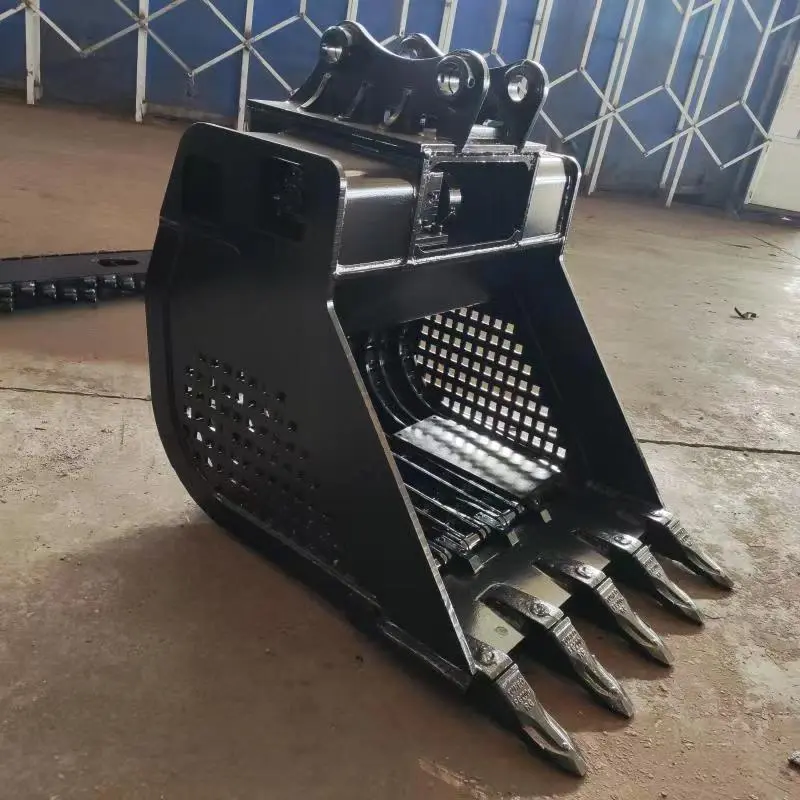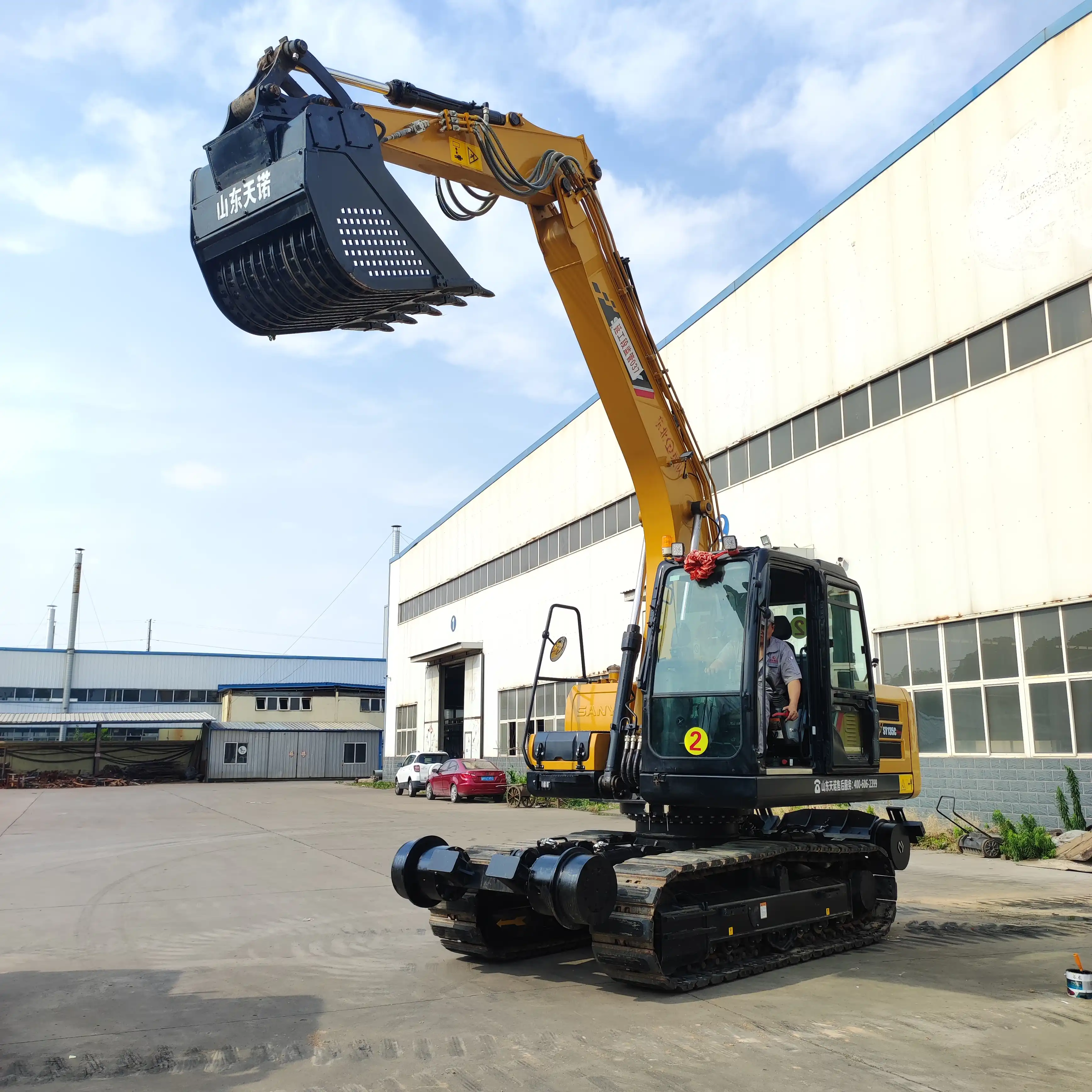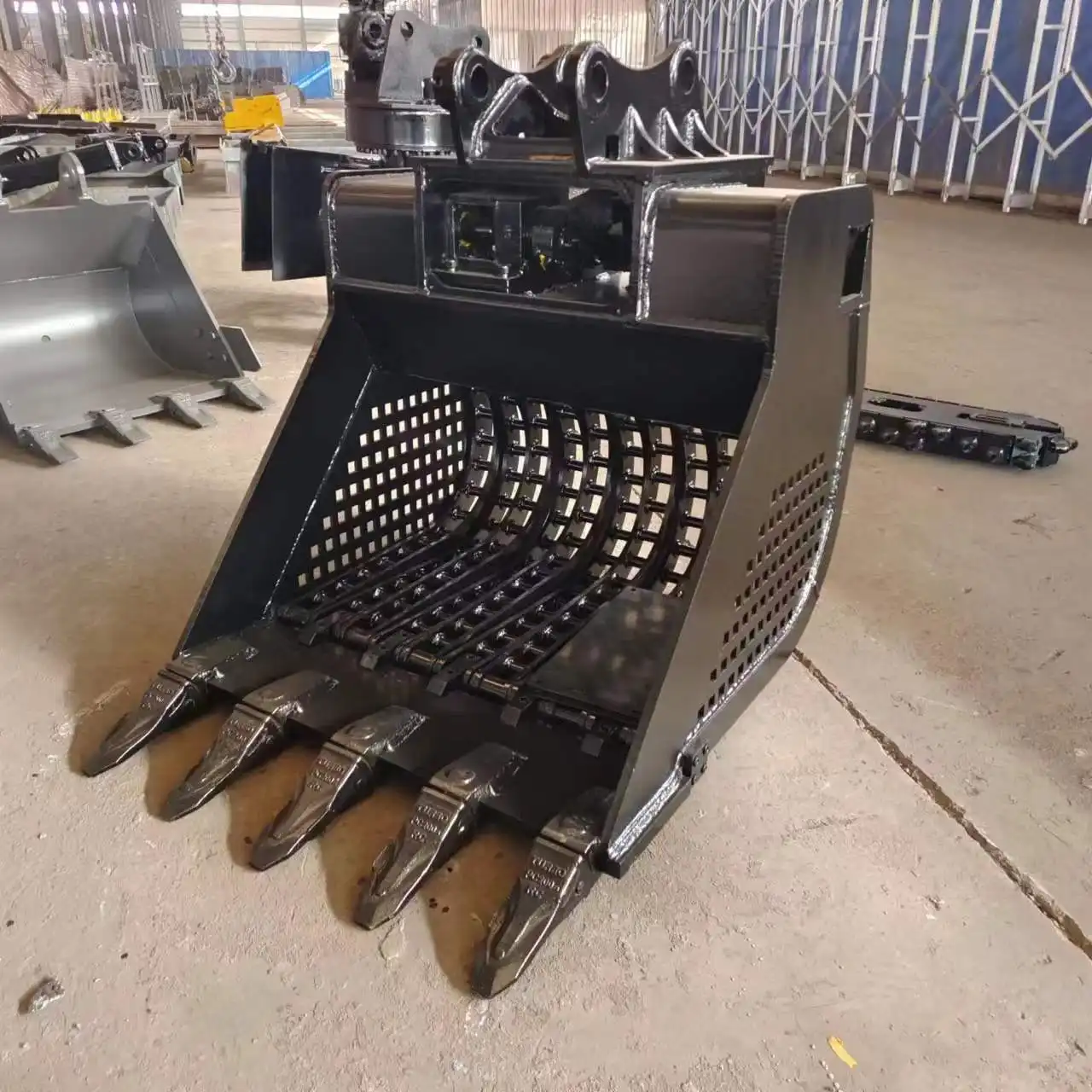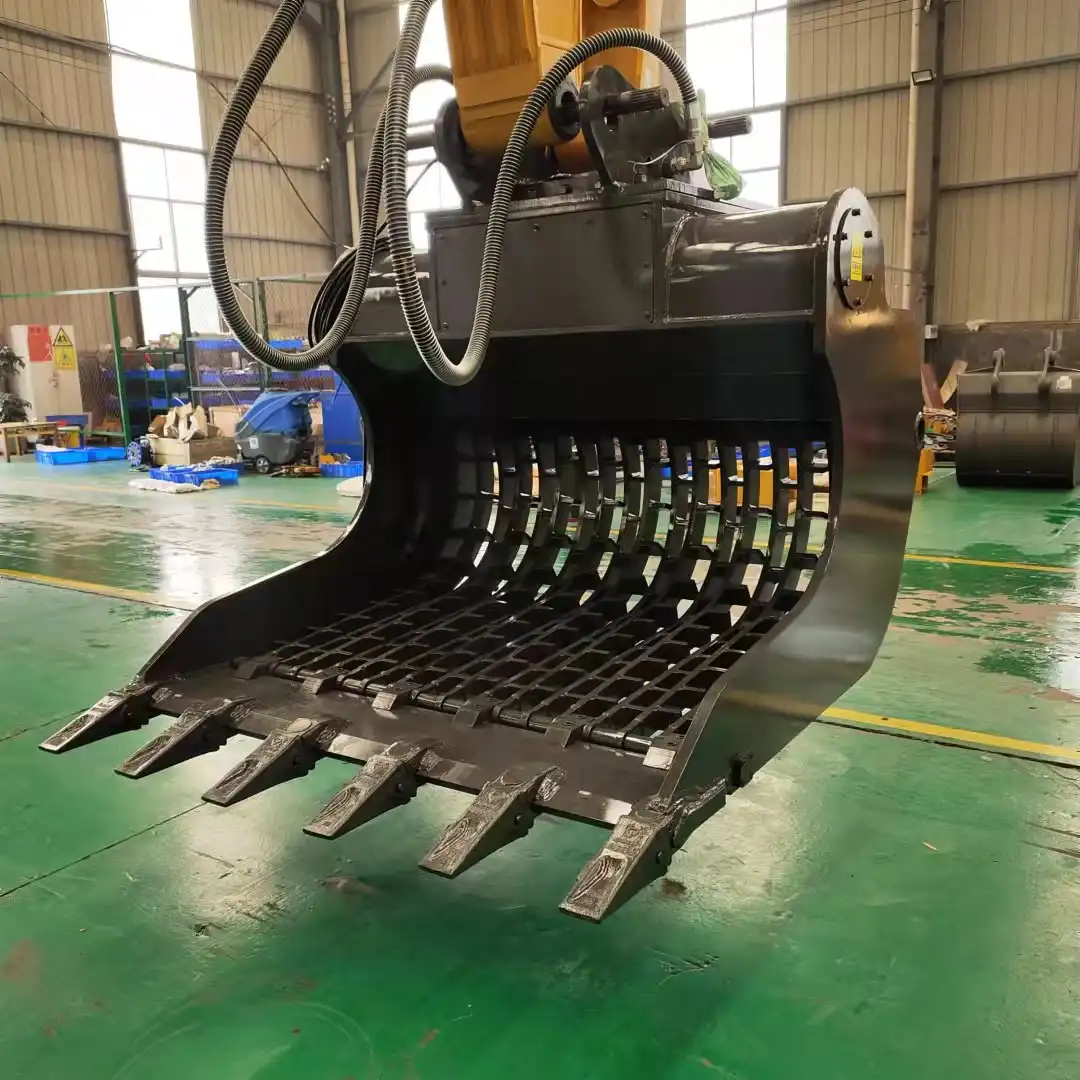What is a screening bucket?
A screening bucket is a specialized excavator attachment designed to separate materials by size, effectively combining excavation and screening operations in a single tool. Unlike traditional buckets, an excavator screening bucket features a mesh or grid-like bottom that allows smaller particles to fall through while retaining larger materials. This innovative attachment transforms any excavator into a mobile screening station, drastically improving efficiency on construction, demolition, recycling, and landscaping sites. By integrating digging and screening functionalities, these attachments eliminate the need for separate screening equipment and additional material handling steps, reducing both operational costs and time requirements. Modern screening buckets are engineered from high-strength steel for durability in demanding environments and feature customizable grid spacings to accommodate various material separation needs, making them versatile tools across multiple industries, from railway maintenance to waste management.
Updated And Customized Funnel

Design Principles
The excavator screening bucket represents a significant advancement in material handling technology. Unlike conventional buckets with solid bases, screening buckets incorporate a carefully engineered grid system that functions as a customizable funnel. This innovative design allows operators to precisely control which materials pass through the bucket and which remain inside for separate handling. The revolutionary aspect lies in the bucket's ability to transform between various operational modes without equipment changes, saving valuable time on worksites.
Modern screening buckets feature adjustable or interchangeable screens that can be modified to match specific project requirements. This adaptability proves invaluable when working across different material types or when project specifications change. For instance, railway maintenance crews can quickly switch from processing ballast to handling larger rocks simply by changing the grid configuration rather than switching to entirely different equipment.
Enhanced Material Processing Efficiency
The customized funnel design of quality screening buckets dramatically improves material processing workflows. Traditional methods often require multiple handling steps, excavation, transport to screening equipment, processing, and then redistribution. A screening bucket consolidates these operations, allowing operators to screen materials directly at the excavation point.
This consolidation yields remarkable efficiency improvements in terms of fuel consumption, labor requirements, and equipment wear. Sites utilizing screening buckets frequently report productivity increases of up to 40% for certain screening operations, particularly when processing mixed debris or salvaging reusable materials from excavation sites.
The immediate separation capability also enhances quality control processes. Operators can visually confirm material segregation as it happens rather than discovering issues after materials have been transported and processed elsewhere. This real-time quality assurance is particularly valuable in applications with strict material specification requirements.
Customization Options for Industry-Specific Applications
Modern screening buckets offer unprecedented customization possibilities to address industry-specific challenges. Manufacturing innovations have made possible specialized features that transform these attachments from general-purpose tools to precision instruments for particular applications:
Railway maintenance operations benefit from screening buckets specifically designed to handle ballast materials, featuring reinforced cutting edges capable of penetrating compacted track beds while simultaneously sorting recyclable ballast components.
Construction and demolition contractors can utilize screening buckets with specialized grid configurations optimized for concrete processing, effectively separating valuable aggregate from reinforcement materials and contaminants.
Landscape professionals rely on screening buckets with finer mesh options that can process topsoil and compost materials while removing rocks, roots, and debris—all without damaging the valuable organic components.
This industry-specific customization extends beyond mere grid spacing. Leading manufacturers now offer specialized cutting-edge profiles, reinforced structural components for high-impact applications, and even hydraulic screen adjustment systems that allow operators to modify separation parameters without leaving the cab.
Sort Loading Materials

Precision Material Separation Technology
The core functionality of an excavator screening bucket lies in its exceptional ability to achieve precision material separation directly at the worksite. Unlike traditional material handling methods that require multiple steps and equipment pieces, screening buckets employ sophisticated engineering principles to sort materials based on particle size with remarkable accuracy.
The screening process occurs as materials pass against the grid surface during bucket movement. This dynamic action facilitates superior particle separation compared to static screening methods. The vibration naturally generated during excavator operation enhances this effect, helping materials find their appropriate paths either through or around the screen elements.
Advanced screening buckets incorporate specialized features that further enhance separation precision. These may include:
Optimized grid patterns are designed to maximize throughput while maintaining separation accuracy. Anti-clogging mechanisms that prevent material buildup on screen surfaces. Progressive screening zones with varying aperture sizes to handle complex material mixes
These technological innovations make modern screening buckets particularly effective when processing materials with challenging characteristics, such as high moisture content or irregular shapes. These conditions often render traditional screening equipment ineffective.
Construction Material Handling
In construction applications, the ability to sort materials directly during loading operations represents a paradigm shift in material handling efficiency. This capability is particularly valuable when working with aggregates, demolition debris, and excavated soils that require classification before use or disposal.
When processing construction materials like gravel, the screening bucket allows operators to precisely grade materials to specification without requiring a separate screening plant. This on-site processing capability not only saves transportation costs but also reduces material waste by enabling immediate reuse of suitable components.
The impact of this technology on paving operations is especially significant. When installing pavers, contractors can use screening buckets to prepare perfect bedding materials directly from site resources. The bucket retains larger stones that would compromise paver stability while allowing appropriately sized sand and fine gravels to create an ideal bedding layer. This precision ultimately translates to superior paving installations with reduced labor and material costs.
Heavy-Duty Attachments that can dig, scoop, and carry a large amount of material

Engineered for Extreme Durability
Modern excavator screening buckets represent the pinnacle of attachment engineering, designed specifically to withstand the punishing conditions of demanding industrial applications. The construction of these attachments reflects a deep understanding of operational stresses and material science.
Premium screening buckets utilize high-strength steel alloys specifically formulated to resist wear, impact, and abrasion. These specialized metals maintain structural integrity even when processing highly abrasive materials like crushed concrete, metal-contaminated demolition waste, or sharp-edged quarry products. The strategic placement of additional wear plates at high-contact points further extends service life in these challenging conditions.
The structural design incorporates sophisticated engineering principles to distribute operational forces efficiently. Reinforced mounting points and load-bearing components ensure that the bucket can handle maximum capacity loads without compromising the attachment interface or the excavator's hydraulic system. This robust construction allows operators to utilize the full power of their machines without concerns about attachment failure.
The grid components themselves represent a particular engineering challenge, requiring both strength and precision. Advanced manufacturing techniques, including computer-controlled laser cutting and automated welding processes, ensure consistent grid spacing and structural integrity. This manufacturing precision translates directly to screening accuracy and attachment longevity.
Versatility Across Multiple Applications
The true value of screening buckets becomes apparent when examining their remarkable versatility across diverse operational scenarios. Unlike specialized attachments with limited applications, quality screening buckets serve as multifunctional tools that adapt to varied material handling challenges:
In excavation and trenching operations, these attachments function as primary digging implements while simultaneously sorting usable backfill materials from excavated soil. This dual functionality eliminates the need for separate processing steps and reduces the equipment footprint on congested job sites.
During demolition projects, screening buckets efficiently separate valuable recyclable materials from waste components. The ability to recover clean concrete, uncontaminated soil, and metal scrap directly at the demolition point dramatically improves recycling rates while reducing processing costs.
For landscaping applications, these versatile attachments excel at soil preparation tasks, removing rocks, roots, and debris while preserving valuable topsoil. The precision screening capability produces consistent results that meet exacting landscape specifications without multiple handling steps.
This operational flexibility makes screening buckets particularly valuable for contractors working across multiple sectors or for equipment rental fleets seeking maximum utilization from their attachment investments.
FAQ

①What is the main purpose of an excavator screening bucket?
The primary purpose of an excavator screening bucket is to combine digging and material separation into a single operation. These specialized attachments allow operators to excavate soil or other materials while simultaneously separating them by size through a grid or mesh bottom. This eliminates the need for separate screening equipment and reduces handling time.
②How do screening buckets differ from regular excavator buckets?
Unlike standard buckets with solid bottoms, screening buckets feature grid openings that allow smaller particles to pass through while retaining larger materials. They're engineered with heavy-duty construction to withstand additional forces during the screening process and often include features like reinforced edges and specialized grid patterns optimized for different materials.
③What materials can be processed with a screening bucket?
Screening buckets can process a wide variety of materials, including soil, compost, demolition debris, mining waste, railway ballast, gravel, sand, and various construction materials. The ideal materials depend on the specific grid spacing and bucket design, with customizable options available for particular applications.
Contact Tiannuo Machinery

The excavator screening bucket represents a transformative innovation in material processing technology, offering unparalleled efficiency for construction, demolition, recycling, and landscaping operations. By enabling simultaneous excavation and screening, these attachments dramatically reduce equipment requirements, labor costs, and processing time while improving material recovery rates and reducing environmental impact. Their robust construction ensures reliability in demanding conditions, while customizable grid configurations provide the versatility needed to address diverse material separation challenges.
Modern screening buckets deliver particular value in applications requiring precise material separation, such as railway maintenance, aggregate processing, and topsoil preparation. The ability to process materials directly at the excavation point eliminates transportation requirements and streamlines workflows, contributing to both economic and environmental sustainability.
As construction and maintenance operations face increasing pressure to improve efficiency and reduce environmental footprints, screening buckets will continue to play an essential role in material handling strategies. Their combination of durability, versatility, and precision material separation capabilities makes them indispensable tools for forward-thinking contractors and equipment fleets.
For more information about high-quality screening buckets engineered for maximum performance and durability, contact Tiannuo Machinery at arm@stnd-machinery.com. Tiannuo's team specializes in custom solutions designed to meet your specific operational requirements with attachments manufactured from premium high-strength steel and featuring industry-leading design innovations.
References
Smith, J. (2023). Modern Excavator Attachments: Innovations in Construction Equipment Technology. Construction Engineering Journal, 45(3), 128-142.
Wong, R. & Johnson, T. (2024). Material Processing Efficiency in Construction: Comparative Analysis of On-Site Screening Methods. Journal of Construction Research, 18(2), 76-91.
Patel, A. (2023). Environmental Impact Assessment of Material Recycling Techniques in Demolition Projects. Sustainable Construction Review, 29(4), 215-230.
Martinez, L. & Thompson, K. (2024). Heavy Equipment Innovations for Railway Maintenance: Case Studies in Track Bed Renovation. Railway Engineering & Maintenance, 37(1), 52-68.
Zhang, H. (2023). Analysis of Material Separation Technologies in Construction Waste Management: Economic and Environmental Considerations. Waste Management Research, 41(3), 112-127.
About Author: Arm
Arm is a leading expert in the field of specialized construction and railway maintenance equipment, working at Tiannuo Company.

